Wings Over the Rockies Air and Space Museum
| formerly Lowry Heritage Museum (1984-1994) | |
 Museum Logo | |
| Established | 1 December 1994 |
|---|---|
| Location |
Denver, Colorado, USA Lowry Campus (formerly USAF base) |
| Coordinates | 39°43′15″N 104°53′44″W / 39.720746°N 104.895530°W |
| Type | Air and space museum |
| Collection size |
Lowry AFB history Colorado aviation history |
| President | Greg Anderson |
| Curator | Matthew Burchette |
| Public transit access | Regional Transportation District |
| Nearest car park | On site (no charge) |
| Website | www.wingsmuseum.org and Facebook |
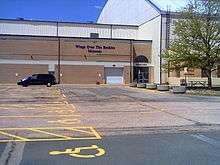
The Wings Over the Rockies Air and Space Museum (WOR) is located on the grounds of the former Lowry Air Force Base in Denver, Colorado. The museum, which opened in 1994, is housed in the 40,000 sq ft (4,000 m2) historic Hangar #1 built in 1939. The museum preserves the history of Lowry AFB's operations from 1938 to 1994 in its collections, archives, and research library. Features of the museum's collection include the USAF's B-1A Lancer and B-52 Stratofortress bombers and many other military and general aviation aircraft.
In 1997, the Colorado State Legislature passed House Bill 1269 that made the Wings over the Rockies Air and Space Museum the official state air and space museum,[1] and the site of the Colorado Aviation Historical Society's Colorado Aviation Hall of Fame.
Overview

The Wings Museum is open daily with exhibits, cockpit demonstrations hosted by volunteers and Civil Air Patrol Cadets. The Museum hosts summer Space Camp events and guided tours of aircraft and cockpits.
The Museum hosts annual events, such as a B-17 Flying Fortress Bomber Fly-in, Denventure and rides at the local general aviation, annual Gala and the Spreading Wings Award.
On April 30, May 1 & 2 of 1999, the official Star Wars Fan Club in conjunction with Lucasfilm held "Star Wars Celebration" at the Museum's location. The first of several official Star Wars fan events, Star Wars Celebration was host to an estimated 20,000 Star Wars fans.[2]
Another resident of the Hangar 1 is the Colorado Air Heritage Museum,[3] sponsored by the Colorado Air National Guard Air Heritage Committee, retired Guardsmen and volunteers that displays the long history of the Colorado Air National Guard.
Aircraft collections
The museum holds over three dozen aircraft in its collection.
Military

- Vought A-7D Corsair II (No. 73-0996, "Speedwell", Colo. Air Nat'l Guard) attack fighter
- Rockwell B-1A Lancer (No. 74-0160) strategic bomber, prototype number 3 and one of only two surviving B-1As of the original 4 made
- Douglas B-18A Bolo (No. 39-25) 1938 medium bomber based on the Douglas DC-2 airliner
- Boeing GB-52B Stratofortress (No. 52-0005) strategic bomber Google Aerial View
- Northrop Grumman EA-6B Prowler arrived fall 2015 from Whidbey Island NAS
- Martin EB-57E Canberra (No. 55-4293) electronic warfare bomber
- McDonnell-Douglas F-4E Phantom II (No. 66-0286, "Julie") fighter-bomber
- Grumman F-14A Tomcat (Bu. No. 159829) fleet defense fighter from VF-211 "NG-102"
- Republic RF-84K Thunderflash (No. 52-7266) parasite tactical reconnaissance fighter from the FICON project
- North American F-86H Sabre (No. 53-1308) fighter
- North American F-100D Super Sabre (No. 56-3417) fighter-bomber
- McDonnell F-101B Voodoo (No. 58-0271) air defense all-weather interceptor
- Convair F-102A Delta Dagger (No. 56-0984) air defense interceptor
- Lockheed F-104C Starfighter (No. 56-0910) fighter-bomber
- Republic F-105D Thunderchief (No. 60-0508) fighter-bomber
- General Dynamics FB-111A (No. 68-0287) fighter-bomber
- Lockheed T-33A Shooting Star (No. 56-1710) trainer aircraft
- Cessna U-3 Blue Canoe (No. 57-5894) trainer aircraft
- Beech UC-45 Expeditor (No. 42-37496) transport aircraft
- Nord 3202-62 French trainer aircraft (No. N2254R)
- Schweizer TG-4 (SGS 2-33) Primary Glider as used by the USAF Academy (No. N1192S)
Civilian

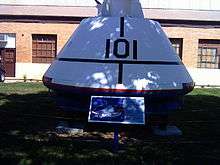
BP-1101A. July 2007.
- Adam M-309 CarbonAero a pre-Adam A500 civilian utility aircraft based on a Burt Rutan design (No. N309A)
- Aviat Pitts Special sport aerobatic biplane aircraft (No. N15JB)
- Ball-Bartoe Jetwing experimental blown wing aircraft
- Christen Industries Christen Eagle II sport aerobatic biplane aircraft with a 230 hp Lycoming engine (No. N6LA)
- HL-20 Personnel Launch System built by Langley Research Center on loan
- Learjet 24 executive jet transport (No. N241JA)
- McDonnell Apollo Boilerplate BP-1101A boilerplate for Project Apollo (No. 101), on loan from Smithsonian
- Murray Model T homebuilt helicopter, 1st to register in Colo. (No. N7222)
- Piper J-3-65 Cub light aircraft with Continental engine (No. N42427)
- Rand Robinson KR-1 homebuilt kit aircraft (No. N60BV)
- Schweizer SGS 1-24 Brigadoon, on loan from National Soaring Museum, Elmira, New York (No. N91888)[4]
- Sky Star Aircraft Corp Kitfox homebuilt kit high-wing aircraft
- Woody Pusher homebuilt high-wing pusher prop with 75 hp Continental engine (No. N393EA)
Previously exhibited
- Alexander Eaglerock, 1926 OX-5-powered biplane produced in Colo., on loan from the Colo. Aviation Historical Society (No. NC2568). The Eaglerock was on display from 1 Sep 1995 to 20 Sep 2013; and now on display at the Pueblo Weisbrod Aircraft Museum.
- Boeing B-29 Superfortress (B-29-60-BW 44-69729 T-Square-54): Arrived December 1986 on low-boy trucks and departed 1996. She was assigned to the 875th Bomb Squadron, 498th Bomb Group, 73rd Bomb Wing and completed thirty-seven bombing missions. Converted to KB-29 (aerial refueling tanker) in June 1949. In December 1986 it was extracted out of the Naval Air Weapons Station China Lake and transported to Lowry AFB's Lowry Heritage Museum (LHM);[5] now Wings Over the Rockies Air and Space Museum. It went through its initial level of restoration in 1987 with LHM's volunteers and was readied for its rebirth and rededication of Lowry AFB's 50th anniversary, 2 October 1987. It was restored to its 1944 markings with the "T Square 54" on its vertical stabilizer. In 1995, the National Museum of the United States Air Force transferred T-Sq-54 to the Museum of Flight in Seattle. After another level of restoration and change in its markings, it was displayed again 1996.
- McDonnell-Douglas F-4C Phantom II was part of the original Lowry Heritage Museum collection and transferred to the city of Fort Collins, Colorado for display in the late 1990s.
- Convair F-106A Delta Dart(59-0134) was part of the original Lowry Heritage Museum collection and transferred to Peterson Air and Space Museum, Peterson Air Force Base, Colorado Springs, Colorado for display in November 1995.[6]
- Vertol H-21C Workhorse (No. 55-4218) displayed as a Lowry AFB H-21B rescue helicopter with AF No. 53-4379 from 1987 to November 2009.
- Goodyear FG-1D Corsair (F4U-1D) (No. N194G) racer, left museum in 2013.
Exhibits and displays
- Space Station Freedom command module mockup built by Martin Marietta with CASIS' Science in Space Exhibit of the ISS
- Lucasfilm X-Wing, 3/4 scale starfighter built to promote the rerelease of the first three Star Wars films in 1997.
- Aircraft engine collection on display
- Nuclear weapons collection on display
- The Aviator Uniform Collection Exhibit Room.
- The Stanley Aviation Ejection Seat Exhibit Room.
- The Cold War Exhibit.
- The History of Avionics Exhibit Room.
- The Colorado Air National Guard Heritage Exhibit Room with Buckley Field and Buckley Air Force Base exhibits.
- The Colorado Aviation Historical Society's Heritage Hall featuring the Colorado Aviation Hall of Fame.
- Rocky Mountain Airways Flight 217 Memorial
Education and services
- Adventures of Flight educational program for children.
- Summer Space Camp program for kids, including space sciences.
- Christmas Kid's Day program for kids winter break in late December.[7]
- Annual Aeromodeling Expo in February for exhibits, inside and outside remote controlled(R/C) aircraft flying, R/C and modeller club displays, and hobby store booths.[7]
- The Technical Research Library Services.
Museum aircraft gallery
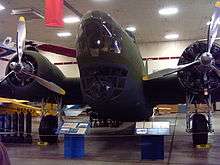 B-18A Bolo
B-18A Bolo
former trainer at Chanute Field, IL B-52B Stratofortress, taken 1999, after the fire
B-52B Stratofortress, taken 1999, after the fire- EB-57E Canberra
former 17th Defense Sys Eval Sqdn 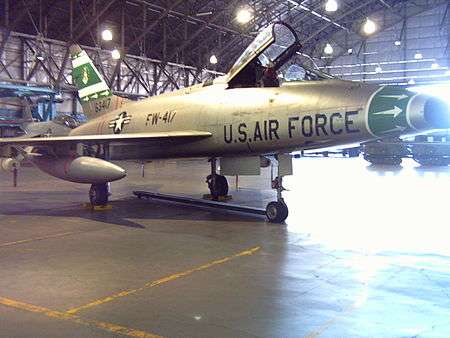
- F-104C Startfighter
former 479th TFW,
(double click on photo for history) - F-105D Thunderchief
former 49th TFW,
(double click on photo for history) - Schweizer SGS 1-24
Brigadoon 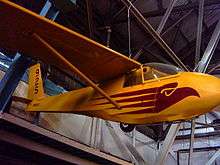 Schweizer SGS 2-33A
Schweizer SGS 2-33A
military TG-4
Detailed aircraft history
B-52B Stratofortress s/n 52-0005 (previously RB-52B)
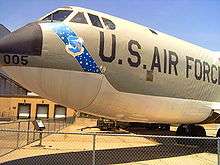
The B-52B was the first truly operational version of this venerable line of Stratofortresses. The RB-52B was nearly visibly identical to the B-52A, but the primary mission was to be an enhanced reconnaissance aircraft with a new bombing/navigation system. A few odd-shape panels and sensors protruded from the rear section as it sloped upward to the tail. A total of 50 were built, with 23 being pure bomber B-52Bs and 27 being dual-capable reconnaissance/bomber RB-52Bs.
Wings Museum’s B-52B, 52-0005, was from the February 1951 contract, as an RB-52B. While at Castle AFB, 005's nickname was known as "Balls 5", went through the conversion to a full bomber. It arrived at Lowry AFB in 1966, as a B-52B, to be assigned to Lowry Technical Training Center as a weapons trainer (GB-52B) and was featured in an air show that summer, before Lowry’s runways were permanently closed that year. Lowry was the premier training site for B-52 ordnance loading and unloading. For 11 years prior, it flew training and live nuclear flights during the Cold War.
Similar to its ‘little brother’ bomber, the medium range B-47 Stratojet, downward-firing ejection seats were provided for the bombardier and navigator, in the case of an in-flight emergency. General LeMay insisted that the tandem seats, again similar to the B-47, as demonstrated in the XB-52, was NOT to be the design and the side by side seating arrangement prevailed. The engines of the B/RB versions were turbojets, J-57s, with water injection, the same engines that had powered the B-52A, and also the F-100C,Ds and the F-102A. Great improvements in engine design and increase in thrust occurred in later versions.
The first B-52B took off on its maiden flight in December 1954. The “Strat” had a complex bombing/navigation system, which combined an optical bombsight, a radar presentation of target, and an automatic computer, together with radar modifications designed for use in a high-speed aircraft. The bomber included a fire-control system for the tail-mounted defensive armament. This B-52B used an A-3A fire control system, which operated a quartet of 0.50-inch machine guns. The last B-52B was delivered in August 1956.
The first change of Balls-5 was in September 1955, when it was converted from the RB to the B, at Edwards AFB. Improvement programs known as Sunflower brought 7 early B-52Bs up to B-52C standards. New Cs and later versions had the Big Belly Modifications. B-52Bs also went through many other modifications in subsequent programs such as Harvest Moon, Blue Band, and Quickclip, which were initially intended for the benefit of subsequent B-52 models. Cold War and training flights with nuclear status were continued.
Historical Dates
- March 3, 1955—RB-52B S/N 52-0005 Boeing Co. Seattle delivered to USAF
- Mar 1955—To 6515th Maintenance Group (Air Research and Development Command), Edwards AFB, California
- Sep 1955—Modified to B-52B configuration
- Oct 1955—To 93d Bombardment Wing (Strategic Air Command) 330th Bomb Squadron, Castle AFB, CA
- Feb 1966—To Davis-Monthan AFB, Arizona for storage
- Jun 1966—To 3415th Maintenance & Supply Group, (Air Training Command), Lowry AFB, Denver, Colorado
- Oct 1975—To Lowry Technical Training Center (LTTC), Lowry AFB, Denver, CO, modified to GB-52B as weapons trainer
- Apr 1982—Dropped from inventory, remained at LTTC
- Circa 1984—Loaned to Lowry AFB Heritage Museum, Lowry AFB
- Dec 1994—Loaned to Wings Over the Rockies Air & Space Museum, Lowry Campus, Denver, CO (museum name change).
Factoids
In June 1959, the sister ship of Wings' Double-O-5, serial number 52-0008, "Balls 8", was transferred to NASA, where it served alongside the NB-52A, 52-0003, as a mother ship for the X-15 rocket plane and with the Lifting Body project (early research for the Space Shuttle program). It was credited with 140 of the 199 X-15 flights. It was still active with NASA's Dryden Flight Research Center at Edwards AFB up until retirement in 2004, where 003 retired in the 90s. 008 retired as the gate guard on October 1, 2004[10] at the entrance to Edwards AFB and 003 retired to Pima Air & Space Museum, Tucson, Arizona.
Specifications of Boeing B-52B/RB-52B Stratofortress
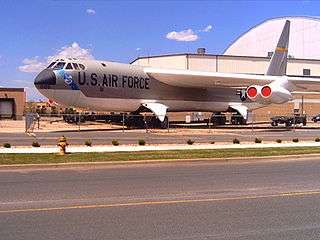
Manufacturer/Model:
- Boeing Co., Seattle, Washington
- Model 464-67
Engines:
- Eight Pratt & Whitney J57-P-1W, -1WA, or -1WB turbojets, each rated at 11,400 lb.s.t with water injection
- Later, -29W/-29WA turbojets rated at 12,100 lb.s.t. (static thrust)
Performance:
- Maximum speed 630 mph (1,010 km/h) at 19,800 feet, 598 mph (962 km/h) at 35,000 feet, 571 mph (919 km/h) at 45,750 feet
- Cruising speed 523 mph (842 km/h) Service ceiling at combat weight 47,300 feet
- Initial climb rate 4750 feet per minute
- Combat radius 3,590 miles (5,780 km) with 10,000 pound bomb-load
- Ferry range 7,343 miles (11,817 km)
- Takeoff ground run ranges from 8200 feet to 10,500 feet
Dimensions:
- Length 156 feet 6.9 inches
- Wingspan 185 feet 0 inches
- Height 48 feet 3.6 inches
- Wing area 4,000 square feet (400 m2)
Weights:
- 164,081 pounds empty
- 272,000 pounds combat
- 420,000 pounds maximum takeoff
Armament:
- Two 20 mm M24A1 cannon with 400 rpg or four 0.50-inch M3 machine guns with 600 rpg in tail turret
- Maximum offensive payload 43,000 pounds (internal and external) with two bomb bays
External Stores:
- 2 inboard wing hard points for bombs, guided cruise-like nuclear bombs, or guided missiles
- 2 outboard wing fuel tanks
Avionics:
- Offensive radar navigation and bombing system
- Defensive radar warning and fire control system for cannons and electronic countermeasures
- Reconnaissance system of cameras, and wide range radio listening and recording equipment.
See also
- CAF Rocky Mountain Wing Museum, Grand Junction, CO
- Colorado Aviation Historical Society, Denver, CO
- Peterson Air and Space Museum, Colorado Springs, CO
- Pueblo Historical Aircraft Society, Pueblo, CO
- Pueblo Weisbrod Aircraft Museum, Pueblo, CO
- Spirit of Flight Center, Lafayette, CO
- Vintage Aero Flying Museum, Hudson, CO
- Related lists
References
- ↑ state.co.us: House Bill 871269
- ↑ See signage on the "front door" photo
- ↑ Other Side of the Mountain Gang: Colorado Air Heritage Museum
- ↑ Natl Soaring Museum: Aircraft on Loan
- ↑ T.Mathewson: T-Square Retrieved from China Lakes Naval Weapons Range
- ↑ Peterson Air and Space Museum
- 1 2 Wings Over the Rockies Air and Space Museum Home page
- ↑ Joe Baugher: 1952 Serial Numbers History
- ↑ Joe Baugher: B-52B History
- ↑ Edwards AFB: Photos and text of the B-52B move
External links
| Wikimedia Commons has media related to Wings Over the Rockies Air and Space Museum. |


